College Application Resume for 2024 [With Examples, Tips & Template]

They say college is the most exciting time in a student’s life and we couldn’t agree more!
The only thing standing between you and your dream university, though, is a college application resume.
You open the resume document, get ready to start writing…
And nothing comes out! After all, how can you even make a resume when you haven’t worked a day in your life?
Worry not - you don’t need any work experience to write a compelling college application resume. In this article, we’re going to teach you just how you can do that!

What Should a Resume for College Application Contain?
- 5+ College Application Resume Formatting Tips
- How to Write a Resume for College Applications?
- 3+ College Application Resume Tips
College Application Resume Template
So let’s dive in!
Before we get into the knits and grits of writing a resume for college application, let’s first do a quick review of what your resume should contain:
- Contact information , including your full name, address, phone number, and professional email.
- A resume objective , where you state the goal of your college application resume.
- Education section , where you list the history of your grades and exam scores.
- Relevant activities , including any work experience you might have.
- Skills relevant to a resume for a college application, e.g. soft skills such as active listening, interpersonal skills, communication skills, or hard skills such as public speaking, MS Office, or computer skills.
- Additional sections , such as awards and honors.
6 College Application Resume Formatting Tips
Before we dive into the nits and grits of CV making, let’s talk about formatting. Here are our top tips on how to format your college application resume:
- Choose the functional/skills-based resume format. This format is perfect for those who lack work experience , as it focuses more on your skill-set. If you DO have some work experience, though, then you can opt for the chronological format.
- Keep your college application resume one page long . As a rule of thumb, this is the optimal length for a resume—professionals with 10 years worth of work experience stick to the 1-page limit, so there’s no excuse for someone with little to no work experience to go overboard.
- Add plenty of white space , especially around your resume’s margins. It will make your resume look less cluttered and more reader-friendly.
- Include clear section headings and use the same heading for each section.
- Use an easy-to-read font. Some resume fonts (such as Ubuntu or Overpass) are resume friendly—professional-looking, easy-to-read, and yet modern. Others, like Comic Sans, are just one big NO.
- Save your college resume as a PDF. You might be used to Microsoft Word, or even think it’s the safest alternative, but MS Word has a good choice of messing up your resume format if opened in different computers or operating systems. PDF files, on the other hand, remain the same no matter what computer opens them.
How to Write a Resume for College Applications? (With Examples)
Once you’ve got the formatting done right, it’s time to get to writing your college application resume.
In this section, we’ll walk you through that process, starting with:
#1. Order Your Contact Information the Right Way
As we already mentioned, your college application resume should start with your contact information.
These are your contact information section must-haves :
- Full name and address
- Functional phone number where you can be reached.
- Professional email address, preferably consisting of your first and last name.
And here’s what this looks like in practice:
Sharon White
123 Main Street
New York, NY
Phone Number: 553-123-1234
Email: [email protected]
#2. Write an Attention-Grabbing College Resume Objective
A resume objective is a 2-3 sentence long paragraph that should communicate your motivation for getting into college or for studying a specific major.
As such, a well-crafted resume objective can instantly attract admission officers to read the rest of your college application resume.
There is, however, a right and wrong way to write a resume objective.
A convincing resume objective is:
- Tailored to the university/major you’re applying to, instead of looking like a one-fits-all kind of statement that you can use to apply to several colleges.
- Highlights the achievements that give you an edge over the competition.
The following example does that right:
Aspiring journalist with a knack for creative writing looking to deepen their knowledge through NYU’s renowned Journalism track. Founder of my high school’s first online newspaper, the ‘Daily Prophet,’ which now has over 2,000 subscribers. Hardworking, with a grade A average in social sciences and commitment to improving.
Now compare it to the following resume objective, which although articulated looks like a one-fits-all kind of statement that you can just insert into several college applications.
Very committed high-schooler with a calling for social sciences. With an SAT score of 1400, a passion for psychology, and experience as a peer counselor, I am confident that my hard work and motivation will shine through as a college student.
See, the resume objective is your chance to show exactly why you want to attend that college, right from the start.
So, even if you don’t have many achievements to highlight, make sure to personalize your statement by expressing a genuine interest in your application.

#3. Put Weight on Your Education
Taking into consideration that, as a student, you most likely lack significant work experience, your education is the first thing admission officers will look at.
As such, you should give your education its due importance in your college application resume.
For starters, make sure to include this must-have information:
- Your high school’s name and location
- The date of your graduation
In addition, though, combine that with some relevant achievements that can make your education pop out.
Let’s take a look at two examples. The second student has simply listed out the essential education information, whereas the first has taken their education section to the next level.
Dunnellon High School FL
2017 - 2021
- 3rd place at the International Mathematical Olympiad
- Vice-President of the Science Club
- SAT Scores: 1350 (650 Verbal, 700 Math)
- SAT Scores: 1400
#4. Showcase Relevant Activities
Extracurricular activities have a great number of benefits when it comes to your college application resume. Most importantly, they:
- Demonstrate you who are outside of the classroom
- Provide an opportunity to showcase your skills
Any activity and/or interest related to the college you’re applying to has a place on your college application resume, but you don’t have to necessarily stop there.
Any kind of interest, field, or activity where you’re good at can be of benefit to your application.
That’s because it can prove that your interests are not focused solely on your favorite subject or desired career path and that you are engaged and well-rounded .
So, don’t just list your college resume activities dryly (e.g. “reading” or “swimming”). Instead, be specific and creative about your interests, and rest assured that you will get extra points for diversity and commitment.
Don’t believe us? Compare for yourself how the activities sections of two different students look like: the first has put minimal effort into it, whereas the second has put his A-game into writing it.
- Passionate about science
- Co-founder of the Astrophysics Club
Activities
- Two-times winner of my high school’s Science Fair
- Co-founder of the Astrophysics Club, finalists of the MIT-founded THINK challenge
- Swimmer from an early age and member of my high school’s swim team during junior and senior year
- Traveling; I have so far visited 10 countries and 15 states in the USA.
- Photography, with a focus on architectural photography.
#5. Highlight Your Work Experience
Now, if you’ve spent your summer holidays working any type of job for teens , that means that you also have some work experience under your belt.
Although work experience is not necessary when you’re applying for college (meaning that you won’t get left out of college if you don’t have any), it does help to include it if you have it.
Here’s how to list work experience in your college application resume:
- Start with the company name (e.g. if you worked at Starbucks), your job title, and the period you worked there.
- Put your job title first if you worked, say, as a high-school tutor or camp counselor.
- Include 1-2 of your main responsibilities in bullets. If you have achievements to show for, however, make sure to put them first.
Let’s see how that works in a practical example.
Starbucks Coffee
- Awarded employee of the month for 3 months straight
- Fielding customer complaints and questions
- Maintaining good customer service and speedy delivery
Even if the above position isn’t related to the student’s desired field of study, the work experience still highlights some of their skills such as commitment, time management, effective communication, and motivation.
#6. Include Your Skills
Skills—we all got them, but not everyone knows how to demonstrate them effectively in a college application resume.
There are two things to consider when you include skills in your college resume:
- Know the kind of skills that are relevant to your major/field.
- Prove your skills, instead of just listing them
Let’s show you how that works through practical examples:
- Time management
- Critical thinking
Are these great skills for a college applicant? Sure!
But anyone can claim to have those skills (and frankly, most people do).
Rather than just listing these skills, you want to also back them up with achievements and experiences like so:
- Attention to deadline: managed to update the high school’s online newspaper daily
- Leadership: successfully led a team of 6 reporters.
- Creativity: won the 2021 Young Writers competition
- Self-motivation: founded the high school’s first online newspaper
Now, this is a skills section on a college application resume that proves you deserve a spot in your favorite university.
College application resume skills
Wondering which skills to include in your college application resume? Here’s a list to draw some inspiration:
Soft Skills
- Good judgment
- Open-mindedness
- Communication
- Self-motivation
- Interpersonal skills
- Active listening
- Problem-solving
Hard Skills
- Computer Skills
- Programming
- Public Speaking
#7. Use These Additional Sections
If you’ve followed all our tips till now, congrats - you’re around 90% into creating a top-notch college application resume.
Now, let’s talk about how you can take that to 100%!
In addition to the conventional resume sections we’ve covered till now, you can include the following to help you stand out in a sea of other applicants:
- Awards. Here, you can list any awards won in competitions (spelling, art, storytelling, math, etc).
- Volunteer experience . Did you clean up your town, or maybe you volunteered at an animal rescue center as a high school student? Any kind of volunteering can help your college application resume because it shows you’re a responsible community member. If it’s somehow related to your field or future major, that’s a big plus.
- Projects. Be them individual (e.g. you built a website from scratch, or started an informational podcast), or school-related (e.g. an art portfolio for a class, or a history documentary), projects can show that you’re passionate and creative.
- Sports. Poet Juvenal said “ a healthy mind in a healthy body. ” This means that physical exercise is an important part of mental and psychological well-being (which is why sports in a college application resume make all applicants look good). Do you excel at specific sports? Include them in your resume!.
- Languages. Being fluent (or even just a beginner) in a foreign language is another plus for a prospective college student. Make sure to show it in your college application resume.
5 College Application Resume Tips
Finally, here are some of our college application tips that didn’t fit anywhere else in the article:
- Be direct and to the point. Your college application resume is not the right place to show how many SAT-level words you know. Keep your language simple, direct, and to the point. Let your achievements and results speak for themselves.
- Don't lie about your academic background or accomplishments. Lying about the awards you’ve won or your achievements won’t get you into college. More often than not, admission officers will see through your lies by asking behavioral interview questions .
- Proofread your college application resume. Spelling and grammar mistakes can make you appear like a less serious applicant. Imagine telling recruiters that you have great SAT scores and GPA but having spelling mistakes in your resume. Kind of contradictory, isn’t it? To avoid these kinds of mistakes, use spelling and grammar apps such as Grammarly and Heminway .
- Have one or more people look at your resume before you send it out. There are kinds of mistakes that Grammarly or Hemingway cannot catch. To avoid such mistakes, have one or more people that know you give your college application resume a look.
- Emphasize specific achievements over general responsibilities. As mentioned before, emphasizing your achievements over your responsibilities is the best way to set yourself apart from other candidates. The reason is that your achievements effectively show how well you handle responsibilities and they are uniquely yours.
Making a resume from scratch can take what feels like ages—especially if it’s your first time doing it.
You’ve got to tweak the formatting.
You make a change at MS Word and the layout falls apart in front of your eyes. Or you end up using a bland and outdated template.
Well, you don’t have to worry about any of these things with Nóvóresume’s free resume templates .
With 8 free templates to choose from - college application resume included - you don’t have to worry about anything other than inputting your information.
Let our resume builder do the rest!

Key Takeaways
And that’s a wrap on college application resumes. We hope to have made the process of writing yours easier and even more enjoyable.
For good measure, let’s go over the main points we covered:
- Your college application resume should contain the following sections: contact information , personal profile , education section , relevant activities , your skills , and additional sections , such as awards and honors.
- In terms of formatting, the functional resume template fits your college application best. Additionally, make sure to keep your resume one page long and save it as a PDF.
- Write a resume objective that doesn’t surpass 3 sentences and that clearly communicates your motivation for getting into college and your most relevant skills.
- Make sure to give your education section its due importance by being thorough about your grades, SAT scores, and achievements.
- Don’t forget to list all your relevant activities and passions, as well as soft and hard skills.
- Instead of writing your college application resume from scratch, use one of Nóvóresume’s ready-made templates to save yourself time and effort!

To provide a safer experience, the best content and great communication, we use cookies. Learn how we use them for non-authenticated users.
*** Enter the $2,000 College Transitions No Essay Scholarship Contest ***
Resume for College Application – Examples & Template
July 8, 2024
College application resumes are different from professional resumes. There’s a certain way your resume for college applications should be to ensure your profile stands out. In one page, your resume will need to cover your academics, background, extracurricular activities and achievements. So to be asked to complete a resume, on top of everything else that goes into the college application? We know, it sounds like a lot. If you’re not sure where to start, you’ve come to the right place. Down below, we’ll dive right into what a college resume is and how to write a college resume. You’ll even find three college application resume examples and a college application resume template to help you start your own.
Let’s have a look at how to begin your resume for your college applications.
What goes into a college application resume?
A resume for your college application, otherwise known as your high school resume, should be one page long. It’s a space for you to show colleges all of your most important activities and achievements that they wouldn’t necessarily know in other parts of your college application. The overall objective of the college application resume is to demonstrate the bigger picture of who you are. It’s essentially a summary of what you’ve done, assembled in a way that serves as a snapshot of your greatest achievements.
There are a few core sections that will go into your college application resume:
– Contact information: Your full name, home address, email and phone number should be at the very top of your college application resume. The header of your resume should have all of this information. This includes any LinkedIn page or personal website that showcases your achievements. – Educational details and academic accomplishments: The full name of your high school and the dates of when you attended should go here. This is where you’ll include your GPA, your AP or IB courses, your ACT or SAT scores and your class ranking, if it’s significant.
College Resume Template (Continued)
Extracurricular activities and work experience: Any special volunteering, internships, part-time jobs, or even had a unique experience studying or working abroad? You should mention those moments here. This section of the resume will amplify what kind of person you are in the community around you. To better understand you as an applicant, admissions officers want to know where you spend your time outside of school. Did you have any leadership positions? Was there a special job or position you had? – Awards and honors: If you have any accomplishments that you’re proud of, you should list them here. This is the part of the college application resume to list achievements like your first prize in a district-wide writing competition or your Most Valuable Player award in your tennis team. Remember, both academic awards and extracurricular awards can be mentioned, so be sure to include any relevant recognitions. – Special skills and interests: Let’s say you speak more than one language and you’re passionate about all things student leadership. Perhaps you know everything about computers. This part of the college application resume is where you should list those unique skills. Think of strong skills and interests you possess, while making sure they reflect your overall college application profile and ambitions. If you have any particular interests or even hobbies that can strengthen your application, then go for it.
Putting together the resume for your college applications can be a tedious process, so it’s best to pay careful attention to every line. You’ll want to focus on the format , style of language , brief but concise descriptions and crucial details .
Resume for College Application – Examples & Templates
College resume template #1.
Here are three different resume examples for college applications. They’ll go from the most basic college application resume to the most detailed:
1) For a standard college application resume, take a look at this student interested in studying anthropology or literature in college. The following is a very standard college application resume:
Dakota Lee 909 Park Avenue Portland, Oregon (012) 345-6789 [email protected]
Bloomington High School, Class of 2024 GPA: 3.85
- Lead students (K-6) in all camp-related activities relating to literature immersion.
- Organize art projects three days a week with senior counselors.
- Coordinate students’ final art show for parents.
- Assisted graduate students in their anthropology research 4 hours every week.
- Presented at the end of every month my own research findings between literature and anthropology.
- President, Student Anthropology Club: 2021-Present
- Vice President, Bloomington Book Club: 2022-Present
- Team Captain, JV Tennis Team: 2021-Present
- First Chair Violinist, Symphony Orchestra: 2022-Present
- High Honors List: 2024
- Principal’s List: 2023-2024
- National Honors Society: 2021-2024
- Most Valuable Player, JV Tennis Team: 2023-2024
- Languages: Spanish, French, Japanese
- Computer: Microsoft Word, Excel, Adobe Photoshop
College Resume Template #2
2) The next college application resume includes more details than the resume above, with a different layout. You’ll find that there is a short description of the student’s character and interests under a section called “Educational Goal” at the top:
Jon Jackson 678 Orange Street Austin, Texas (123) 456-7890 [email protected]
Educational Goal
Diligent, driven student with a passion for business and economic development. Dedicated to improving the livelihood of small businesses across the state of California. Focused on collaborating with business leaders, community organizers and students across the country to create a stronger, more sustainable economy.
High School Diploma 2024 Springfield High School Austin, Texas GPA: 3.98 Courses: AP Calculus, AP Physics, AP Macroeconomics, AP US History, AP Spanish
Austin Chamber of Commerce – Student Representative 2021-2024 Austin, Texas – Served as representative of public schools across the city of Austin, advocating for student perspectives on Austin’s economic initiatives. – Developed campaigns and city-wide initiatives to encourage more student involvement in local elections, distributed pamphlets door-to-door to invite neighborhoods to participate in city-wide census polls. – Relayed information from commerce meetings back to our school district. – Advocated for the support of small businesses. – Created a bimonthly “Student Visit Day” to continue open communication between decision makers and high school student leaders across Austin.
- President, Business Club 2021-Present
- Treasurer, Young Economists 2022-Present
- Student Volunteer, Save the Children 2022-Present
- Editor, Springfield Student Gazette 2022-Present
- High Honors List 2024
- Principal’s List 2023-2024
- National Honors Society 2021-2024
- Best Student Entrepreneur, Business Club 2023-2024
- Languages: Spanish, German, Arabic
- Advocacy, Debate, Public Speaking
- Microsoft Word, Excel, Adobe Photoshop
College Resume Template #3
Now let’s look at a college application resume that has a different structure and even more details. Keep in mind the first two resumes you just saw above:
Cassandra Zimmerman Los Angeles, CA ✦ (012) 987-6543 ✦ [email protected]
Driven student with a track record of community and student leadership. Passionate about women’s rights and girls’ education, eager to make a difference through service and mentorship. Committed to applying my leadership and communication skills to contribute to my college community, I am excited to major in business marketing and sociology to create a better working environment for women around the world.
High School Diploma Expected in June 2024 Valley High School Los Angeles, CA GPA: 3.88 – Awards: Academic Achievement Award (2021-2023), Community Service Excellence Award (2022-2023), Student Role Model Award (2024) – Courses: AP Microeconomics, AP Literature, AP European History, AP Spanish, AP French – Clubs: Journalism Club, UNICEF Club, Girls Empowerment Club, Entrepreneurial Club – Sports : Track and field team captain
- Critical thinking
- Innovation and adaptability
- Project management
- Organization and coordination
Professional Skills
Leadership – Led a team of 10 senior students across the Los Angeles School District to meet with the Mayor of Los Angeles and discuss our hopes for women in business. – Steered the track and field team as team captain, maintaining a positive spirit throughout every season. – Initiated the weekly column of our student newspaper to focus on areas of local community improvement. Communication – Showcased results from community polling to 50 members of the school district leadership. – Proactively participated in journalism club, leading student investigation pieces on local incidents affecting women-led businesses. – Collaborating across different school clubs to foster an interdisciplinary education and promote a united community. Computer and Technology Proficiency – Highly skilled in Microsoft Excel to aggregate and process data, while also proficient in the entire Microsoft Office Suite applications. – Adept in creating social media campaigns on X (formerly known as Twitter), Instagram and TikTok.
Work History
University of Southern California, Young Leaders Internship 2022-2024 Los Angeles, CA YMCA Girls Leadership 2021-2024 San Francisco, CA
Volunteer Experience
UNICEF Local Chapter Volunteer 2021-2024 Volunteered as a student leader UNICEF member for our local chapter every month. Disseminated pamphlets and helped organize Los Angeles events that focused on girls’ education. Mentoring freshmen with All Hands On Deck 2022-2024 Served as a mentor to freshmen students across the Los Angeles Unified School District. Coordinated activities with arts organizations and businesses across the city to help struggling students have more access to educational and extracurricular resources. Dog Rescue Volunteer 2021-2024 Participated as a weekly volunteer at the local animal shelter to help clean, feed and walk dogs. Promoting adoption events and animal rescue awareness across the city.
College Application Resume Styles
By looking at the resumes for college applications above, you’ll see that the three are quite different from each other. The first was a very simple college application resume example, while the second was a bit more informative, though not entirely. The third college application resume example provided more background information and relevant details. However, it’s always important to keep in mind that you’ll want your college application resume to be around one page.
The top general tips for writing your resume for college applications are:
1) Write your contact information and professional email address. Make sure your email address is something that colleges won’t have to think twice about.
2) Begin with education . Colleges know that you won’t have a lot of work experience. They’re academic institutions, so first and foremost, they’re interested in your academic performance. Start your college application resume with your education.
3) Bulleted lists over paragraphs. Elaborate on your achievements and experiences with brief descriptions in bullet points, not in lengthy paragraphs . Admissions officers will want to read clear and concise descriptions that are straight to the point.
4) Use strong action verbs that empower you. If you led a group of children at camp or presented your research in front of a committee, use an action verb that encapsulates your responsibilities. This means that instead of writing “It involved leading groups of children…” try something like “Directed groups of children to…”
5) One page does the trick. It’s tempting to want to make your resume as long and informative as possible. But the moment that happens, the quicker the reader will lose interest. College admissions offices are looking through thousands of applications. Keeping your college application resume concise will only work in your favor. Doing so is also a great exercise for future job applications and helps you decide what you really want to focus on sharing.
As seen from the examples above, you can personalize the style of your college application resume. But a general college application resume template will look like the following:
Your name Home address, City, State (Your) phone number | [email protected]
The name of your high school City, State, Year of Graduation
GPA: Your score ■ SAT: Your score ■ ACT: Your score
Relevant Coursework : The names of any relevant, important classes
Your role, The name of your experience City, State, Year
- Description of your experience.
Awards/Honors
- The name of your award: Date you were awarded
Description of your award. Any specific numbers and information that provides more context.
Additional Skills
List your skills that are relevant to your overall college application. They can be both professional and unique skills.
Resume for College Application – Examples & Template – Additional Resources
- How to Complete the Common App Activities Section
- How to Complete the Honors Section on the Common App
- 300 Best Colleges in the US
- Common App Essay Prompts 2024-25
- 10 Instructive Common App Examples
- How to Brainstorm a College Essay
- Application Strategies
Joanna Hong
With a BA from Pitzer College and an MA from University College London, Joanna has worked in London, Berlin, and Los Angeles covering many cultural and political issues with organizations such as Byline Media, NK News, and Free Turkey Media. A freelancer for The New York Times, her work has also appeared in Newsweek, Dazed and Confused Magazine, and The Guardian, among others. In addition, Joanna was the recipient of the 2021 PEN America Emerging Voices Fellowship in Fiction and is currently completing her first novel.
- 2-Year Colleges
- ADHD/LD/Autism/Executive Functioning
- Best Colleges by Major
- Best Colleges by State
- Big Picture
- Career & Personality Assessment
- College Essay
- College Search/Knowledge
- College Success
- Costs & Financial Aid
- Data Visualizations
- Dental School Admissions
- Extracurricular Activities
- General Knowledge
- Graduate School Admissions
- High School Success
- High Schools
- Homeschool Resources
- Law School Admissions
- Medical School Admissions
- Navigating the Admissions Process
- Online Learning
- Outdoor Adventure
- Private High School Spotlight
- Research Programs
- Summer Program Spotlight
- Summer Programs
- Teacher Tools
- Test Prep Provider Spotlight
“Innovative and invaluable…use this book as your college lifeline.”
— Lynn O'Shaughnessy
Nationally Recognized College Expert
$2,000 No Essay Scholarship
Presented by College Transitions
- Win $2,000 for college • 1 minute or less to enter • No essay required • Open to students and parents in the U.S.
Create your account today and easily enter all future sweepstakes!
Enter to Win $2,000 Today!
- English (UK)
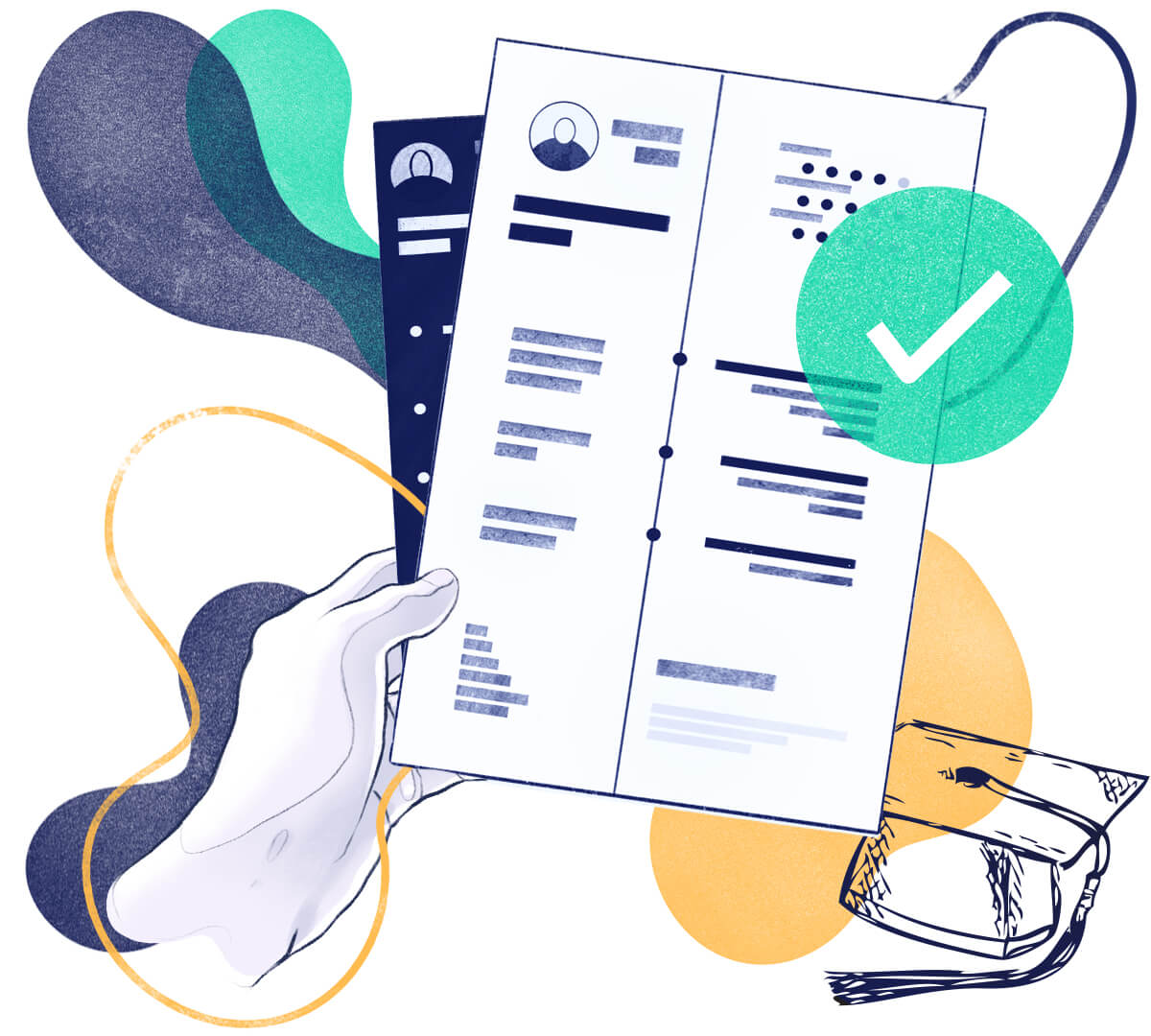
- Resume Examples
How to Write a College Application Resume (+ Examples)
Looking for the perfect college resume template? Learn how to write your college application resume with this guide and secure a spot in the top colleges.

You spent a long time in high school, studying diligently to grasp the chance to finally get into college.
To show admission officers that you’re the best candidate to join their prestigious school, you might need a resume for college application. If that sounds daunting, don’t worry. I’ll show you how to write a resume that gets you into college.
In this guide, I’ll show you:
- 4 college application resume examples.
- How to write a resume for college application that gets you into the best institutions.
- What to include on a high school resume for college.
- Tips & tricks to get your college resume template noticed.
Save hours of work and get a job-winning resume like this. Try our resume builder with 20+ resume templates and create your resume now.
Create your resume now
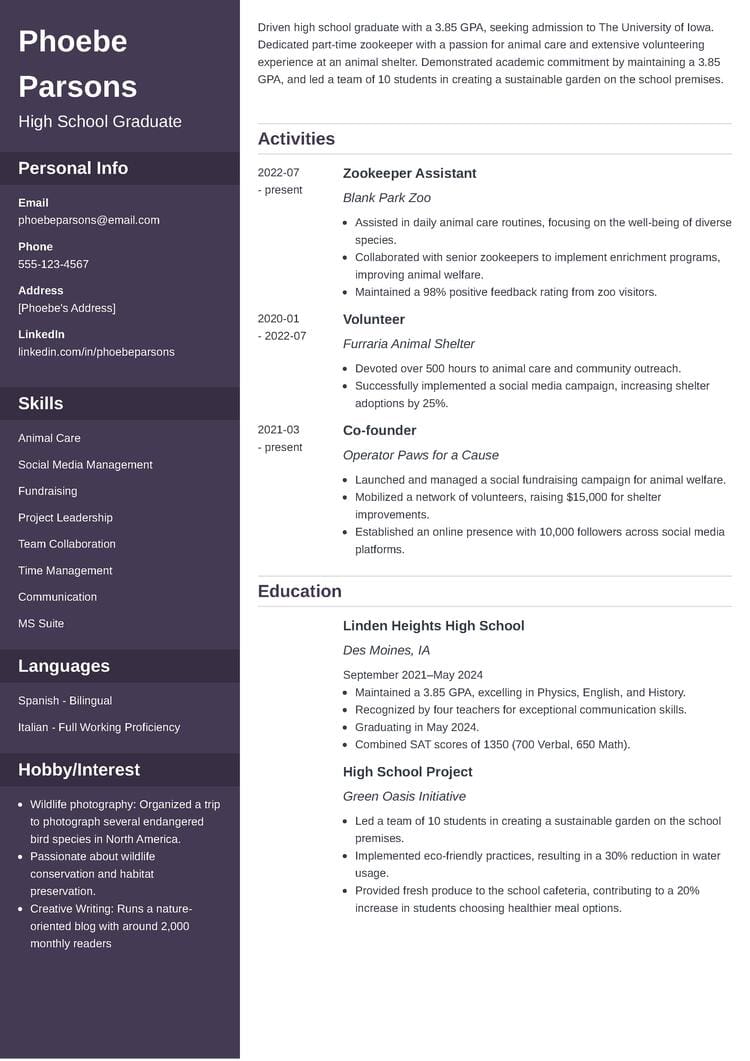
What users say about ResumeLab:
I had an interview yesterday and the first thing they said on the phone was: “Wow! I love your resume.” Patrick I love the variety of templates. Good job guys, keep up the good work! Dylan My previous resume was really weak and I used to spend hours adjusting it in Word. Now, I can introduce any changes within minutes. Absolutely wonderful! George
Looking for a different kind of college resume? We've got you covered:
- Academic CV Template
- College Freshman Resume
- College Student Resume
- Engineering Student Resume
High School Graduate
- High School Student Resume
- Law School Application
- Law Student Resume
- Recent College Graduate Resume
- Undergraduate College Resume
Our review of over 500,000 resumes built with our tool revealed that*:
- Students usually finish building their resume in just 26.3 minutes.
- The most popular resume templates for students are Cascade, Diamond, and Concept.
- Problem-Solving, Teamwork, Collaboration, Adaptability, and Multitasking rank as the most common skills listed by users.
- 29.73% of our users include certifications on their resumes.
* The data comes from the last 12 months (August 2023-August 2024).
Now, I’ll show you one fantastic college application resume. You can find the other three at the bottom of this article.
College Application Resume Example
Phoebe Parsons
Personal Info
Address: 731 Bay Ridge Dr, Iowa City, IA 52246
Phone: 555-123-4567
Email: [email protected]
LinkedIn: linkedin.com/in/phoebeparsons_11
Driven high school graduate with a 3.85 GPA, seeking admission to The University of Iowa. Dedicated part-time zookeeper with a passion for animal care and extensive volunteering experience at an animal shelter. Demonstrated academic commitment by maintaining a 3.85 GPA, and led a team of 10 students in creating a sustainable garden on the school premises.
Linden Heights High School, Des Moines, IA
September 2021–May 2024
SAT: 1350 (700 Verbal, 650 Math)
- Excellence in Environmental Science Award, 2023
- Academic Excellence Scholarship, 2022
High School Project: Green Oasis Initiative
- Led a team of 10 students in creating a sustainable garden on the school premises.
- Implemented eco-friendly practices, resulting in a 30% reduction in water usage.
- Provided fresh produce to the school cafeteria, contributing to a 20% increase in students choosing healthier meal options.
Work Experience
Zookeeper Assistant
Blank Park Zoo, Des Moines, IA
July 2022–May 2024
- Assisted in daily animal care routines, focusing on the well-being of diverse species.
- Collaborated with senior zookeepers to implement enrichment programs, improving animal welfare.
- Maintained a 98% positive feedback rating from zoo visitors.
Furraria Animal Shelter, Des Moines, IA
January 2020–July 2022
- Devoted over 500 hours to animal care and community outreach.
- Successfully implemented a social media campaign, increasing shelter adoptions by 25%.
Co-founder, Operator
Paws for a Cause, Des Moines, IA
March 2021–May 2024
- Launched and managed a social fundraising campaign for animal welfare.
- Mobilized a network of volunteers, raising $15,000 for shelter improvements.
- Established an online presence with 10,000 followers across social media platforms.
- Animal Care
- Social Media Management
- Fundraising
- Project Leadership
- Team Collaboration
- Time Management
- Communication
- Spanish—Bilingual
- Italian—Full Working Proficiency
- Wildlife photography: Organized a trip to photograph several endangered bird species in North America.
- Passionate about wildlife conservation and habitat preservation.
- Creative Writing: Runs a nature-oriented blog with around 2,000 monthly readers
A college application resume adds extra information to your college application document. It gives admissions officers a quick look at your achievements and experiences, helping to assess your suitability and readiness for college.
Do You Need a Resume for College Application?
You should use a resume for your college applications when you're applying to colleges, scholarships, or even certain academic programs that ask for a detailed account of your experiences. It's also a good tool to have ready for college fairs, meetings with admission counselors, and during the application process itself.
However, it is not a necessity in all places. For example, the University of Virginia’s FAQ states that they don’t accept college application resumes .
Even if there is a chance you won’t need a college resume, I still recommend you write one. Not only will it help you stand out if you can include it, but it’s also good training for when you’ll inevitably need to look for your first/next job.
Now, I’ll tell you how to write a resume for college applications that opens the doors to the best colleges:
1. Pick the Best Format for College Application Resume
There are around 57,000 applicants that try to get into Harvard each year. And only about 2,000 get admitted. So, about 3.5–4%. To be in the 4% that do get in, you need to have jaw-dropping academic achievements from high school.
But that’s not all. Your college application resume format needs to be flawless. I’ll give you a formula for the best college resume template:
- Pick a professional, simple resume template . It will make the process much quicker.
- Use the best resume fonts , like Cambria, Georgia, or other Serif-type fonts, in 10–12pt. Add big headings, utilize white space, and set 1-inch margins on your resume .
- First, create your resume header . Add your name, address, phone, email, and social media links. Do not include a photo.
- Write a one-page resume . One page is the perfect length for a resume for college applications.
- Save your resume as a PDF rather than a DOC . PDFs are machine-readable and keep their formatting on all software and devices. However, some colleges will prefer other file types or applications through The Common App .
Expert Hint: Since you’re applying to college, you might’ve heard the term CV being tossed around. But you don’t need to create a detailed CV when writing a high school resume for college. If you’d like to learn more about the differences between CVs and resumes , click the embedded link.
2. Show Educational Prowess
If there is one part you really need to focus on when writing a high school resume for college, it’s the education section . But, you’ll include a bit more information than if you were writing a resume tailored for a job .
A university cares for your grades. So you need to show your GPA and SAT. And it’s kind of non-negotiable. Normally I’d only recommend you show your GPA if it’s 3.5 or higher , but you’re not applying for a job this time.
You can also highlight your best A+ subjects. On top of that, include additional information that shows your commitment to gaining knowledge, as well as other practical, relevant achievements gained during high school.
These can include:
- Academic Honors and Awards
- Advanced Placement (AP) or International Baccalaureate (IB) Courses
- School Projects or Research
- Extracurricular Academic Activities
- Relevant Workshops
- Study Abroad or Exchange Programs
- Club Activities
See the examples below on how to create a great education section.
Education on a High School Resume for College—Example
New West Charter School, Los Angeles, CA
2020–2024
- Co-Captain of Track Team.
- SAT Scores >1300
The first of these two examples shows you weren’t just stuck to your classroom desk. It presents stunning achievements that are certain to catch an eye. Meanwhile, the second example is bland and gives an inconclusive SAT score value, even though the candidate still appears to have a strong academic background.
I’ll give a word of advice in case your GPA isn’t that high: Different universities and programs have varying acceptance criteria, so it’s wise to prepare a second or third choice in case you’re not admitted into your first one. Additionally, a 3.2 GPA from one of the top high schools in America may be viewed more favorably than a higher GPA from a lesser-known school.
Expert Hint: If you’ve already graduated from college, present your university projects, relevant coursework , scholarships, and other achievements you can pull from your time studying.
3. List Work Experience on a Resume for College Applications
Look, work experience isn’t necessary here. But if you have some experience that’s relevant to the course you’re pursuing, adding it to your college application resume will be a huge boon.
That’s because, through work experience , you show that you have practical knowledge and skills alongside your theoretical knowledge.
Here are some types of work experience you may want to include:
- Full-Time Employment
- Part-Time Employment
- Contract Work
- Freelancing
- Internships
- Volunteer Work
These examples of high school resumes for college show how:
Work Experience on a Resume for College—Example
- Assisted in daily animal care routines, including feeding, cleaning enclosures, and monitoring animal health.
Local Zoo Animal Care Intern
- Assisted zookeepers with daily animal care tasks.
- Facilitated educational tours.
- Performed various project tasks as assigned by senior zookeepers.
- Attended staff meetings and briefings.
The second example only shows a small list of job responsibilities and no impressive work achievements . It’s just too underdeveloped to impress anyone. Meanwhile, the first sample shows resume bullet points that are both detailed descriptions of responsibilities and quantified accomplishments.
Expert Hint: Remember to prove as many statements as possible by providing details. Strong college application resume bullet points like “Successfully implemented a social media campaign, increasing shelter adoptions by 25%” are incredibly effective. Also, start each sentence with an action verb .
The ResumeLab builder is more than looks. Get specific content to boost your chances of getting the job. Add job descriptions, bullet points, and skills. Easy. Improve your resume in our resume builder now .
CREATE YOUR RESUME NOW

Nail it all with a splash of color, choose a clean font, and highlight your skills in just a few clicks. You're the perfect candidate, and we'll prove it. Use our resume builder now .
4. Showcase Your Skills
In the previous section of the article, I briefly mentioned skills once. This time, I’m going to talk about resume skills in more detail. This is because you need to write a skills section on your college application resume.
Normally, you’d do it to target some resume keywords from the job application. This time, you’re mostly targeting what the admission officer might value. This means hard skills that are important for the curriculum and soft skills that highlight your character and potential contributions to the university community.
Don’t copy any lists you find on the internet. Always take your time and choose 5–10 most relevant skills. Here’s a list of some of the most common ones for inspiration:
Skills for a College Application Resume
- Communication Skills
- Strong Work Ethic
- Collaboration
- Self-Motivated
- Fast Learner
- Critical Thinking
- Creative Thinking
- Presentation
- Negotiation
- Interpersonal Skills
- Physically Fit
- Problem-Solving
- Tech Skills
- Computer Skills
- Programming
- Public Speaking
- Social Media
Expert Hint: If you don’t know the differences between hard and soft skills , click the embedded link to learn all about this subject.
5. Add Extra Sections to the Resume
Take as much time as you need and list interesting activities on your college resume. Hobbies, interests & extracurricular activities on a college admission bring a plethora of advantages . Think of these activities that are:
- Relevant to the course you want to enroll in.
- Prove vital skills.
What activities can you show on a resume for college applications?
- Class Rank: if it’s impressive.
- Gained Certifications : They prove your skills and show your dedication and motivation towards learning a specific subject.
- Volunteer Work : Unless you added it under your work experience section.
- Community Projects: Have you done public service or built a website? Projects show your dedication to a goal.
- Sports: Don’t just list sports on a college resume. Add accomplishments like races won or records broken.
- Professional Memberships: Include memberships in professional organizations or academic societies that are relevant to your field.
- Publications: List any articles, research papers, or blog posts you have authored or contributed to, particularly those related to your field of study.
- Positions: List captainships, Eagle Scout rank, or positions in church or 4-H groups. Those all energize high school resumes for college.
- Hobbies & Interests : Are you good at robotics? Crafts? Relevant hobbies prove you can work toward a goal.
- Known Languages : Command of a foreign language looks great on college application resumes.
Here are two examples:
Examples of Bonus Sections on a Resume for College Application
Best Project Award: Coding Club, 2022
- Recognized for developing a comprehensive library management system using Python, enhancing the school's book inventory and borrowing process.
- High School Coding Competition Winner: 2022
- First place in a school-wide coding competition, demonstrating outstanding programming skills and innovative problem-solving.
Certifications
- Introduction to Computer Science (CS50), Harvard University (edX), June 2023
- JavaScript Algorithms and Data Structures Certification, freeCodeCamp, May 2023
- Python for Everybody Specialization, University of Michigan (Coursera), April 2022
- HTML, CSS, and JavaScript for Web Developers Certification, Johns Hopkins University (Coursera), January 2021
- Participation Award, Science Fair, 2020
- Certificate of Attendance, School Assembly, 2019
- Certificate of Completion, Online Time Management Course, 2021
- Attendance Certificate, Public Speaking Workshop, 2019
The bad example is presented by the Four Horsemen of Bad Resumes. Lack of relevance, Vagueness, Generalized titles, and Insignificant achievements. It’s not going to impress anyone.
6. Craft a Powerful College Resume Objective
Now that your high school resume for college is ready, it’s time for a finishing touch.
Universities receive tens of thousands of applications each year. To browse through them efficiently, the admission counselors can’t spend much time looking at each one. With only a couple of seconds to pique their interest, you need a strong resume introduction .
With a good resume objective , you’ll present the admission officers with something that will open their eyes faster than a project deadline. Use:
- A resume power adjective (enthusiastic, passionate).
- “High school graduate” or “student”.
- GPA if above 3.5.
- Your goal (seeking admission to The University of Iowa)
- An attention-grabbing achievement (led a team of 10 students in creating a sustainable garden)
Here is a practical example of what to do and not do:
College Application Resume Objective—Example
Resume Objective
Passionate high school graduate with a 3.3 GPA and 1300 combined SAT scores. Graduating from high school in May 2024.
The first example is effective because it succinctly highlights the candidate's outstanding GPA, combines academic excellence with relevant, practical experiences, and showcases leadership through a sustainability project.
The bad example falls short because it lacks depth. It offers only basic information without providing insights into the candidate's character, skills, or accomplishments. It's generic and doesn't engage the reader with meaningful details.
If you graduated from high school long ago, pursued a career, and are only now trying to get into college, use a resume summary . Instead of focusing strictly on your academic achievements, present 1–2 quantified professional work achievements. Especially if they’re relevant to the course you’re trying to get into.
To finish the college application resume part, I prepared a handy checklist you can use to see if your resume for college application is ready:
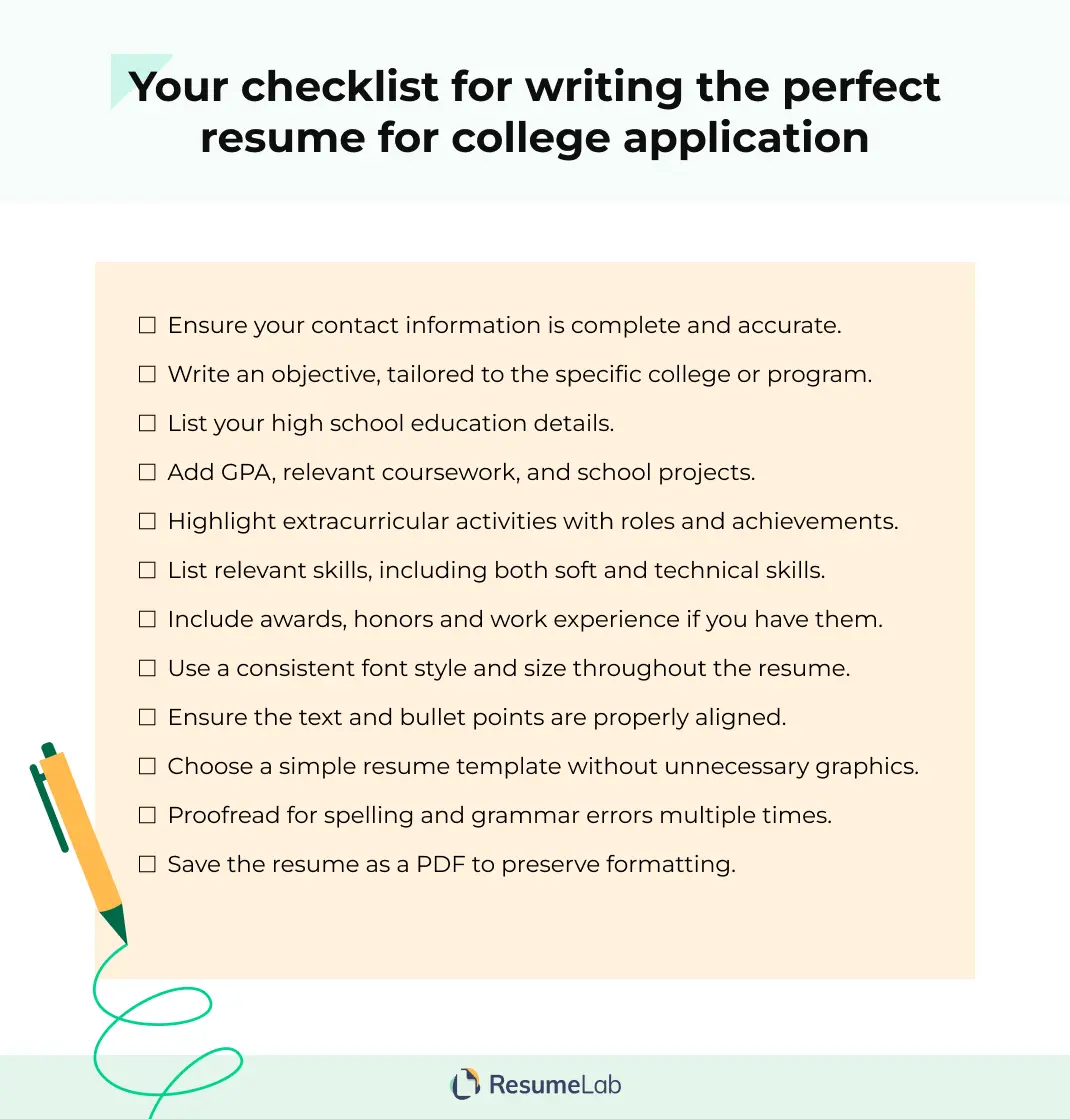
7. Supply Your College Application Resume With a Cover Letter
One more thing before we wrap things up. Some colleges will require you to send a cover letter and your college application resume. Other ones will not specify, even though they most likely consider cover letters necessary .
Keep to the standard cover letter format . Start with your and the recipient’s contact information. Next, write an introductory paragraph that works similarly to the resume profile. In the middle section, showcase your achievements and skills. In the end, focus on your motivation and values.
You can learn how to write a cover letter from our guide.
Expert Hint: Do you have what it takes to win a scholarship? Write a scholarship resume and a scholarship cover letter that will make you stand out from the crowd.
More College Application Resume Examples
As I said in the beginning, here are 3 more resumes for college applications you can use as templates or just get inspired by.
The first sample comes from a recent high school graduate with zero work, internship, or volunteering experience. Through this candidate, I’ll show you some great ways to expand on your education section.

Sample College Application Resume With No Work Experience
John A. Smith
Address: 3535 E Cook St, Springfield, IL 62703
Email: [email protected]
Phone: (123) 456-7890
LinkedIn: linkedin.com/in/johnasmith_06
Dedicated high school graduate with a strong interest in computer science. Seeking to pursue a Bachelor's degree in Computer Science at the University of Illinois to develop technical skills and contribute to innovative projects. President of the school coding club, who Created a library management system using Python to better handle book inventories, member registrations, and borrowing records.
Springfield High School
Springfield, IL
September 2021–June 2024
GPA: 3.5/4.0
Honors & Awards
- Honor Roll: Fall 2020, Spring 2021, Fall 2021, Spring 2022
- National Merit Scholar, 2023
- Winner of the High School Coding Competition, 2022
Club Memberships & Activities
- Coding Club: President, organized school coding workshops, hackathons, and guest speaker sessions.
- Robotics Club: Member, contributed to designing and programming robots for regional competitions.
- Math Team: Captain, led the team to first place in the inter-school math competition.
- Chess Club: Member, participated in local and state-level chess tournaments.
School Projects
Personal Portfolio Website
- Designed and developed a personal portfolio website using HTML, CSS, and JavaScript to showcase school projects and coding challenges.
- Integrated responsive design techniques to ensure optimal viewing on various devices.
Library Management System
- Created a library management system using Python to handle book inventories, member registrations, and borrowing records.
- Implemented a user-friendly graphical user interface (GUI) for efficient interaction.
Weather App
- Developed a weather application using JavaScript and API integration to fetch real-time weather data.
- Implemented features such as location-based weather updates and a five-day forecast.
High School Coding Competition Winner : 2022
- Front-end Development
- Responsive Design
- Linux/Windows
- Attention to Detail
Programming Languages:
As you can see, this candidate focuses mostly on his school projects to show that he’s driven, motivated, and possesses practical knowledge.
If you never did school projects, you can always substitute them with personal projects. Treat them similarly, so focus mainly on what you did and what impact these projects made.
Now, I’ll switch focus from an inexperienced high school graduate to an experienced working professional who wants to finish university to help them get a promotion and advance in their career.
Sample Resume for College Application for an Experienced Professional
Mary L. Thompson
Office Manager
Address: 6109 S Langley Ave, Chicago, IL 60637
Email: [email protected]
Phone: (456) 789-0123
LinkedIn: linkedin.com/in/marylthompson
Resume Summary
Experienced office manager with 5 years of professional experience in office administration and team management. Seeking to pursue a Bachelor's degree in Business Administration at the University of Illinois-Chicago to further professional growth. As a manager at Bright Solutions, streamlined office operations, resulting in a 20% increase in productivity and efficiency. Successfully managed a budget of $500,000, reducing operational costs by 15% through effective vendor negotiations and resource optimization.
Professional Experience
January 2019–Current
Bright Solutions, Chicago, IL
Key Responsibilities:
- Managed day-to-day office operations, ensuring a smooth and efficient workflow.
- Supervised and supported a team of 10 administrative staff, including hiring, training, and performance evaluations.
- Coordinated meetings, conferences, and travel arrangements for senior executives.
- Oversaw budget management, procurement, and vendor relations.
- Implemented office policies and procedures to improve efficiency and compliance.
- Maintained office equipment and supplies, ensuring optimal functionality and availability.
Key Achievements:
- Streamlined office operations, resulting in a 20% increase in productivity and efficiency.
- Successfully managed a budget of $500,000, reducing operational costs by 15% through effective vendor negotiations and resource optimization.
- Developed and implemented a new employee onboarding program, reducing turnover by 25%.
- Recognized for exceptional leadership and awarded Employee of the Year in 2020.
High School Diploma
Springfield High School, Springfield, IL
Graduated: June 2013
Honors & Awards:
- Honor Roll: Fall 2012, Spring 2013
- Member of the National Honor Society
- Management Skills
- Team Leadership
- Office Administration
- Budget Management
- Policy Development
- Organizational Skills
- Project Management Software (Asana, Trello)
- Database Management
- Certified Office Manager (COM), International Association of Administrative Professionals (IAAP), March 2021
- Project Management Professional (PMP), Project Management Institute (PMI), July 2020
- Certified Microsoft Office Specialist (MOS), Microsoft, January 2018
Professional Development
- Leadership and Management Training: Completed a series of workshops on leadership, team building, and conflict resolution through the American Management Association (AMA), 2019-2021.
- Business Communication Course: Attended a business communication course focused on enhancing written and verbal communication skills, 2020.
Memberships
- International Association of Administrative Professionals (IAAP), Member
- Project Management Institute (PMI), Member
- American Management Association (AMA), Member
Unlike the previous candidate, this one uses her work experience as the main section of the college application resume. Since she graduated high school a long time ago, her education section can be put on the backburner.
But, If she were applying for a Master’s program, she would’ve benefited greatly from expanding her Bachelor’s education section.
Let’s combine these two college application resumes to create a recent high school graduate candidate with some work experience.
Sample College Application Resume for a Recent Graduate With Work Experience
John A. Doe
Recent High School Graduate
Address: 3101 Lakeshire Dr, Springfield, IL 62707
Email: [email protected]
LinkedIn: linkedin.com/in/johndoe
Enthusiastic and dedicated high school graduate with a 3.84 GPA, one year of internship experience at a hotel, and two years of relevant volunteering experience. Seeking to pursue a Bachelor's degree in Hospitality Management at the University of Illinois to develop industry-specific skills and contribute to creating exceptional guest experiences. Committed to continuous learning and professional growth in the hospitality sector.
Graduated: June 2024
GPA: 3.8/4.0
Relevant Coursework: Business Studies, Economics, English, Marketing, Hospitality and Tourism Management
- Honor Roll: Fall 2022, Spring 2023, Fall 2023, Spring 2024
- National Honor Society Member
Senior Project:
- "Revamping Guest Experience in Local Hotels": Conducted research on guest satisfaction and proposed strategies for improving services in local hotels. Presented findings to school faculty and local business leaders.
Club Memberships & Activities:
- Business Club: Vice President, participated in business plan competitions and community outreach programs.
- Student Government: Treasurer, managed the budget and financial planning for school events.
Hotel Assistant Intern
June 2023–June 2024
Grand Springfield Hotel, Springfield, IL
- Assisted in daily operations at the front desk, including guest check-ins and check-outs.
- Provided concierge services, answering guest inquiries and arranging reservations.
- Supported event planning and coordination for weddings, conferences, and banquets.
- Collaborated with the housekeeping team to ensure rooms met the hotel's high standards.
- Maintained a welcoming atmosphere in the lobby, greeting guests and providing assistance.
- Improved guest satisfaction scores by 15% through exceptional service and prompt issue resolution.
- Played a key role in organizing three large-scale events, contributing to their successful execution.
- Received commendation from supervisors for dedication and professionalism.
Volunteer Experience
June 2022–June 2023
Springfield Community Center, Springfield, IL
- Helped increase event participation by 20% through effective promotion and outreach.
- Recognized for exceptional organizational skills and ability to work under pressure.
- Contributed to raising over $10,000 in funds for community projects.
- Guest Services
- Event Planning and Coordination
- Front Desk Operations
- Housekeeping Coordination
- Concierge Services
- Certified Guest Service Professional (CGSP), American Hotel & Lodging Educational Institute, March 2024
- CPR and First Aid Certification, American Red Cross, January 2023
- Future Business Leaders of America (FBLA), Member
- Hospitality and Tourism Management Association (HTMA), Member
And that’s how you can combine both your expansive academic achievements and work experience.
Double your impact with a matching resume and cover letter combo. Use our cover letter generator and make your application documents pop out.
CREATE YOUR COVER LETTER NOW

Want to try a different look? There's 21 more. A single click will give your document a total makeover. Pick a cover letter template here .
For a college application resume that puts you in a toga:
- Use the college resume template at the top.
- Set the right college application resume format. That way, you’ll show you’re organized and take things seriously.
- Make your education section meaningful. Show accomplishments in your high school student resume education section.
- List resume activities in your bullet points. Add details and numbers that show you’re not playing around.
- Add a college application cover letter. In it, elaborate on your achievements, motivations, and personal aspirations.
Do you have any questions about how to write a high school resume for college that sparkles? Are you still not sure what goes on a resume for a college application? Leave a comment. I’ll happily reply.
About ResumeLab’s Editorial Process
At ResumeLab, quality is at the crux of our values, supporting our commitment to delivering top-notch career resources. The editorial team of career experts carefully reviews every article in accordance with editorial guidelines , ensuring the high quality and reliability of our content. We actively conduct original research, shedding light on the job market's intricacies and earning recognition from numerous influential news outlets . Our dedication to delivering expert career advice attracts millions of readers to our blog each year.

Mariusz is a career expert with a background in quality control & economics. With work experience in FinTech and a passion for self-development, Mariusz brings a unique perspective to his role. He’s dedicated to providing the most effective advice on resume and cover letter writing techniques to help his readers secure the jobs of their dreams.

Was it interesting? Here are similar articles

Entry-Level Cover Letter Examples, Tips & Writing Guide
Learn how to write a cover letter with no experience, a first job cover letter, or an entry-level cover letter that makes the best impression. It's easier than you think!

Christian Eilers
Career Expert

10 Proven Tips To Make Your Resume Stand Out in 2024
Is your resume decent but doesn’t bring you any interviews? Read on to uncover how to make resumes stand out from peers.

Marta Bongilaj, CPRW
Certified Professional Resume Writer, Career Expert

How to Write a Motivation Letter: Sample & Guide for 2024
Did you lose another recruitment process? This can drain your motivation. Maybe what you need is to motivate the recruiter. Do so with a splendid motivation letter!

Mariusz Wawrzyniak
- Skip to Content
- Skip to Sidebar
- Skip to Footer
Resume Genius
The World's Smartest Resume Builder
Monday to Friday, 8AM – 12AM (Midnight) and Saturdays and Sundays, 10AM – 6PM EDT (866) 215-9048
Blog Resume Help Resume for a College Application
How to Write a Resume for a College Application
An effective college resume is essential for getting accepted into your dream school as a high school graduate. Scroll down to find out how you can write a college application resume that helps you get into the college you want.

As featured in *
What is a college application resume?
How important is a college application resume, what should you include on a resume for a college application, college application resume template, resume for college application example, 8 tips for writing a college application resume.
Prefer audio? Tune into our podcast coverage of this article:
To get accepted into college, you need an excellent college application resume.
And because there are hundreds of other prospective students competing for the same spot, you want your resume for college to stand out.
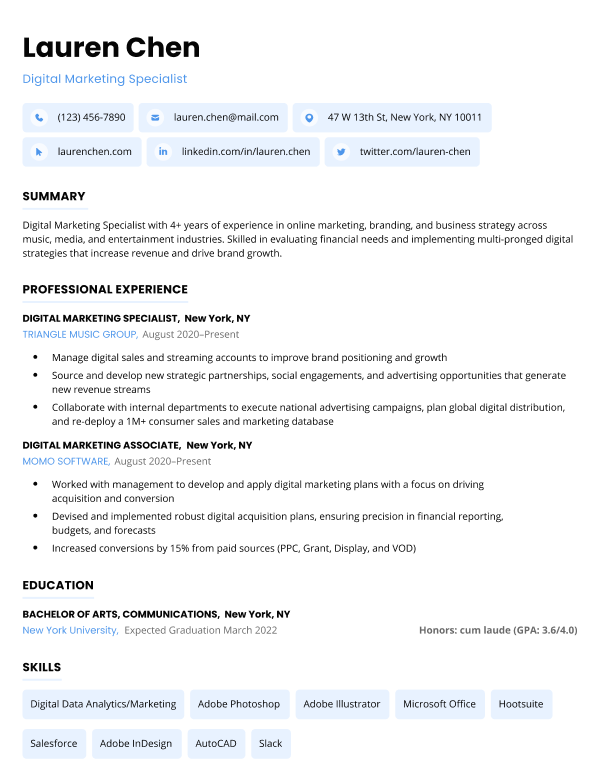
Our free-to-use resume builder can make you a resume in as little as 5 minutes. Pick the template you want, and our software will format everything for you.
A college application resume is a one page document that describes your talents, skills, work, or volunteer experience, and a brief overview of your academic achievements.
To win a spot in your chosen college, you need to showcase important information about yourself that will give you an advantage over other applicants.
To create that advantage, you should learn how to make a resume for colleges that highlights your skill set and personality.
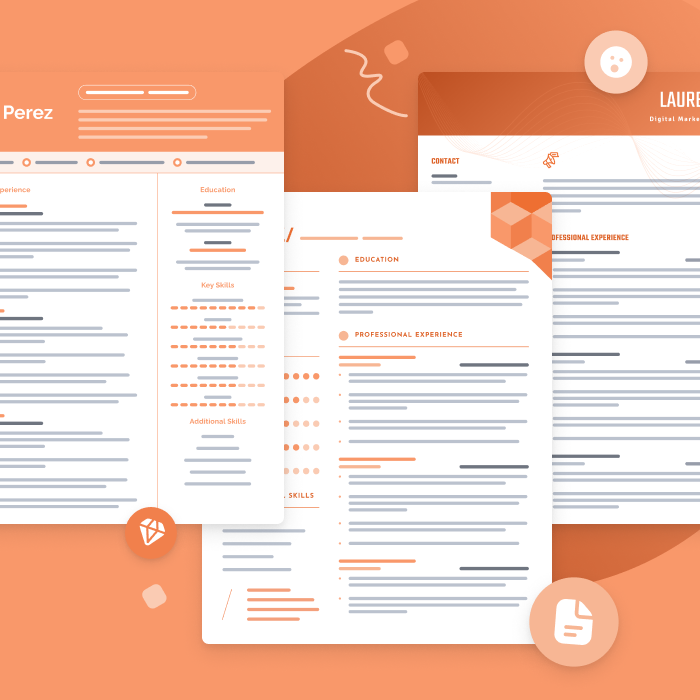
The best resume templates for 2024
One of the best ways to make your resume is by filling out one of our free resume templates. All our templates are designed by experts and free to download for Microsoft Word or Google Docs.
A college application resume can help you get into universities, but it can also hurt your chances of getting accepted — so writing a good college resume is important if your goal is to go to a university or community college after graduating high school.
Also, note that writing a high school resume for a college application is different from writing a regular resume.
Colleges want to know you can balance your academic life with other activities like sports or clubs.
Admissions officers also want to see that you’re able to take initiative and be self-motivated, so highlight any projects where you’ve taken the lead or been proactive.
So tailor your information to the specific school or program you’re applying to by including relevant extracurricular activities, volunteer experience, leadership roles, awards, and honors.
For example, if your target college is well known for a specific sports program, then show your love of sports by listing the sports teams you’re on and your position on those teams.
When writing your resume for college admissions, list your relevant experiences and skills. Type your name , phone number , and email clearly at the top of your resume before you write anything else.
Here’s what to include when writing your college application resume:
- Resume header (with contact information)
- Resume objective statement
- Education section (with GPA , SAT/ACT scores, class rank)
- Extracurricular activities
- Work experience
- Volunteer work
- Hobbies and interests
- Relevant skills
- Awards and publications
To make it easier for you to write a college application resume, check out our template below that you can copy, paste, and customize:
1. Resume Header
First and last name.
Email: [email protected] | Phone: 713 220 7452 | Address: 53 Lance Avenue, Dallas, TX 30217
2. Resume Objective
Motivated and dependable [student/individual] seeking to pursue my academic goals and career path at the distinguished [Name of University]. Currently studying at [Name of school]. Possess [relevant skill #1], [relevant skill #2] and a passion for personal development and student involvement. Looking for an opportunity to develop my knowledge and make a significant contribution as a student for the upcoming [# of year] school year.
3. Volunteer Experience
Most recent volunteer title.
Employer Name | Location | Start Year–End Year
- Use 3–5 bullet points for each entry to explain your responsibilities
- Begin each bullet point with a resume action verb to portray yourself as a student leader so college admissions committees can see what you’ve done (e.g., Raised $10,000 in fundraising efforts for Hurricane Alex which resulted in helping 1350+ displaced citizens in the Central Caribbean)
- Add hard numbers (like percentages, dollar amounts, time spent, number of teammates) within your bullet points to highlight your accomplishments (e.g., the total number of hours you volunteered at an event or worked part-time)
Earlier Volunteer Title
- Use past tense verbs if the experience has already happened (e.g., “supervised,” “guided,” “won”)
- Be specific when writing your resume (e.g., list the actual names of events you were a part of, number of people you assisted, or tools and software you used)
4. Education
High School Name | Location | Graduation Date (or the date you intend to graduate)
For example, Ohio Liberty High School, Columbus, OH | Graduation: 2022 | GPA: 3.8/4.0
- If you don’t have any volunteer experience, list your education at the top of your college resume (underneath your resume header)
- Include your academic highlights and relevant coursework using hard numbers (e.g., Coached 15+ elementary students in freestyle swimming, basic first aid, and breathing techniques from September 2020 until June 2022, resulting in my winning the “Top Student Coach” award of June 2022)
5. Skills Section
List 3–6 hard and soft skills as bullet points that relate to the college’s values, culture, or mission statement (e.g., organizational skills , leadership skills , teamwork skills, and people skills are skills that show you’ve made positive contributions in past roles)
6. Additional Experience
Show employers more of your accomplishments or additional skills by including other sections such as your hobbies and interests , extracurricular activities, or foreign language skills
The best way to work out what to put in your college admissions resume is to read the resumes of other successful applicants. Here’s a student resume example for a college application:
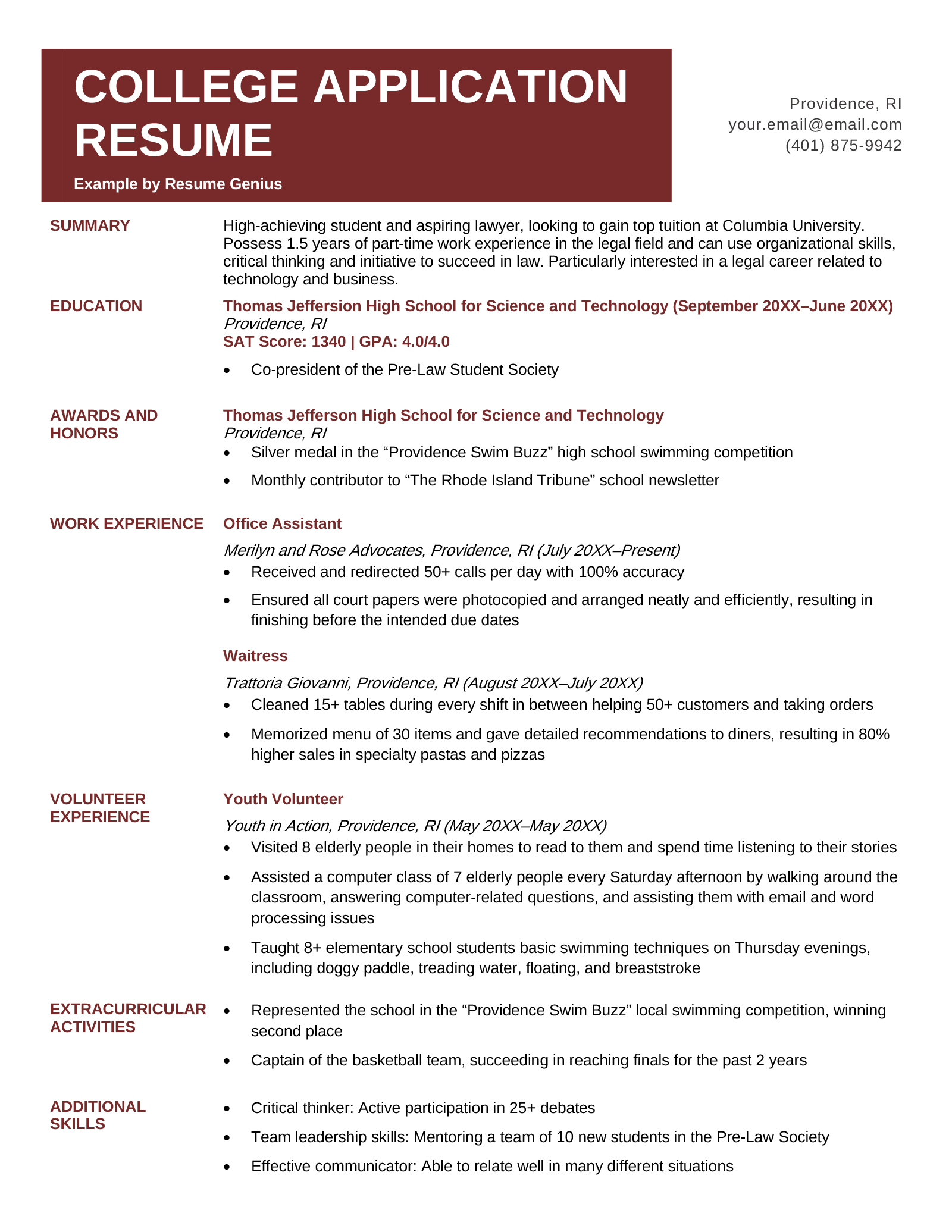
As a student, you should present a resume that showcases your personality, academic accomplishments, and extracurricular activities.
So here are eight ways to capture the attention of college admissions committees:
1. Tailor your resume to each college
You might have come here looking for how to create a resume for college, but the truth is you’ll need to create several — one for each college you’re applying to. Why?
Because each college is different, and you should adjust your resume to reflect the requirements of each college.
So study the college you want to apply to by reading its requirements carefully. Look for what features stand out at the particular college and build on them.
For example, if you’re applying to an arts-focused school, try starting your resume with a resume section called “creative accomplishments” or “artistic talents.”
2. Include resume keywords for your college resume
Use appropriate resume keywords when writing your college resume.
Colleges and workplaces use applicant tracking software (ATS) to filter, rank, and review applicants, so ensure your resume uses specific keywords that the software identifies for your college application to be considered.
So write an ATS-friendly resume by making sure your headings are clear, your listed experience and skills are chronological, and the right keywords are in the right places.
3. Format your college application resume correctly
What should your college resume look like? While there’s a range of options, go for a simple, professional format, rather than something too complicated.
That way, the admissions committee can locate your qualities and achievements easily — without being distracted by the design.
Choose a professional resume font like Times New Roman or Arial, and use it throughout your resume. Set your font size to 10–12 points so it’s easy to read.
Set the heading text larger for each of your headers so they clearly separate each section of your resume .
Finally, set the margins to 1” on all sides to give your resume a professional finish.
4. Write an excellent resume objective statement
A resume objective sits at the top of your resume and details your training, credentials, and skills.
Keep your resume objective clear and focused by targeting it to the college’s needs by using 2–4 concise sentences to explain why that particular college will help you accomplish your goals.
Use the rest of your resume to back up everything you write in your resume objective.
This is an example of a college applicant’s resume objective:
Example of an applicant's college resume objective
An ambitious and conscientious high school graduate with a creative mind, seeking admission to Baylor University to further my skills in fashion. Great interpersonal skills, exceptionally stylish, and ready to take the fashion industry by storm.
5. Include a detailed education section
Your resume’s education section provides essential details about your educational background.
When writing a resume for college, there are a few things that make a great education section.
To start, include the most important details first (like graduation year) so an admissions member reading this section can easily access your information.
Also, keep the details in your education section short and concise so you can showcase your most relevant information.
For instance, try using resume bullet points to break up long lists of activities, honors, and awards into more manageable chunks.
If your grades are lower than expected, you may want to include your GPA closer to the bottom of your resume so that the committee can view your other top skills, activities, and experience rather than dismissing your resume because of your grades.
6. List activities on your college resume
Resumes for college admissions are more than just your academic records and extracurricular activities.
Your resume shouldn’t be just a list of information — it needs to describe who you are as an applicant. So make sure to tell your story instead of only summarizing your grades and extracurricular activities.
What’s your passion? What do you like to do? If you’re interested in politics and ran for student government, mention that you competed as a political candidate in your school.
If you love to write and you volunteered to write for your school newspaper, state that you served on your school newspaper.
7. Highlight your work and volunteer experience
Mention any volunteer services you did like babysitting, raking leaves, dog walking, mowing lawns, or any other work.
Colleges want action takers — students who are keen to make a difference in society — and to stand a better chance, address both your hard and soft skills .
Hard skills are the abilities you acquired through learning, practical experience, or training. Some examples are coding, foreign language skills , driving, and computer skills .
Soft skills show how you relate with others in a workplace or college setting. These personality traits include time management skills , listening skills, communication skills , critical thinking, or problem solving skills.
Schooling, working, and volunteering helps you develop both types of skills. And if you can show the admissions board that you’ll relate well with fellow students in their institution, you’re more likely to get accepted in their college.
So ensure you add both soft and hard skills in the skills section of your college application resume.
Don’t be tempted to lie about your achievements. You may think this makes a better college application resume but being dishonest may hurt your chances of entering or staying at a college if admissions committees find out the truth.
8. Emphasize specific achievements rather than general duties
When listing your extracurricular activities and achievements, write experiences that are relevant to a particular college to stand a better chance of getting admitted.
List specific achievements instead of generalizing by using hard numbers and relevant details , so that the admissions committee can be clear about where you stand in relation to other applicants.
For instance, instead of just saying you like sports and are part of student clubs, your list of achievements should include which sports teams, clubs, and other activities you’ve been involved in at school.
Here’s an example of a college resume’s experience section with hard numbers:
College resume example with hard numbers and details
- I volunteered in a community clean-up and established garbage bins that saw a 95% reduction in litter
Next, take a look at this college application resume example without hard numbers:
College resume example without hard numbers and details
- I was part of a community clean-up
Try separating these activities into categories such as “volunteer work” and “community service” to make it easier for the admission board to scan your resume.

Eva Chan, CPRW
Career Expert & Senior Digital PR Writer (CPRW)
Eva Chan is a Senior Digital PR Writer and Certified Professional Resume Writer (CPRW) at Resume Genius. Born and raised in Vancouver, British Columbia, Eva is passionate about researching and discussing the ever-changing career space and its latest trends, and channels this enthusiasm into supporting professionals of all experience levels so they stand out in a competitive job market. Eva graduated from the University of British Columbia with a bachelor’s degree in English. Eva's insights and career advice have earned recognition from leading platforms including CNBC, Harvard Business Review, The Globe and Mail, Forbes, Newsweek, and Entrepreneur. For any media-related queries or for a future quote, you can reach her at [eva] @ [resumegenius.com] or connect with her via LinkedIn. Please note that we don’t accept any guest posts.
Subscribe to our newsletter
By clicking “Submit” you agree to receive marketing communications from our site, and to our Terms & Conditions and Privacy Policy . You can unsubscribe at any time.
Thanks for subscribing!
We're thrilled to be a part of your professional journey! Stay tuned for the most up-to-date job news, free resources, and expert advice for your job hunt and career.
Resume for a College Application
Click to rate this article
4.3 Average rating

Related Articles
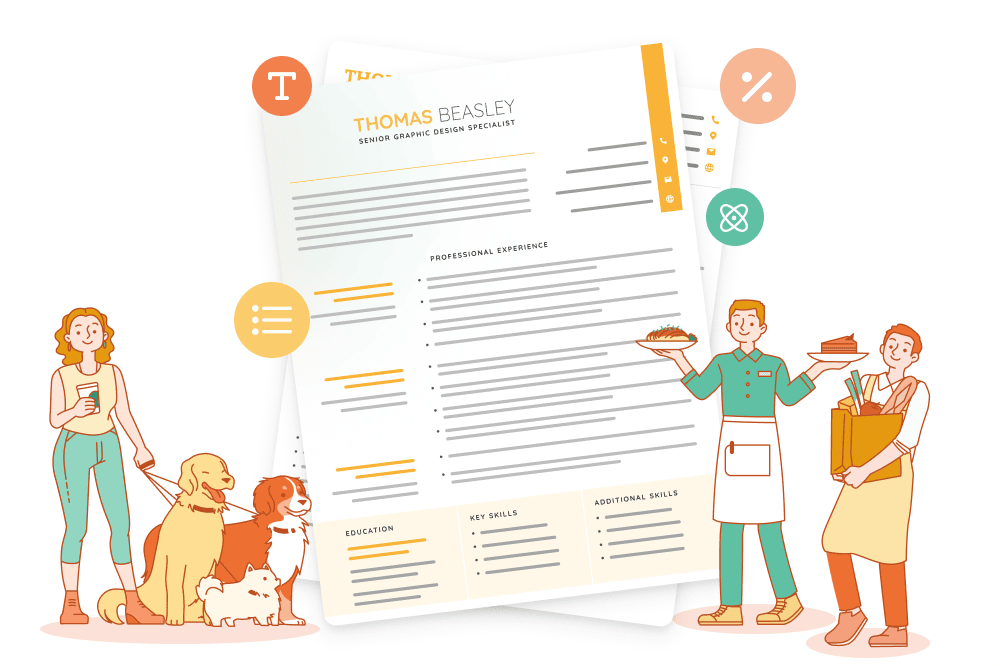
Resume Help

Conrad Benz
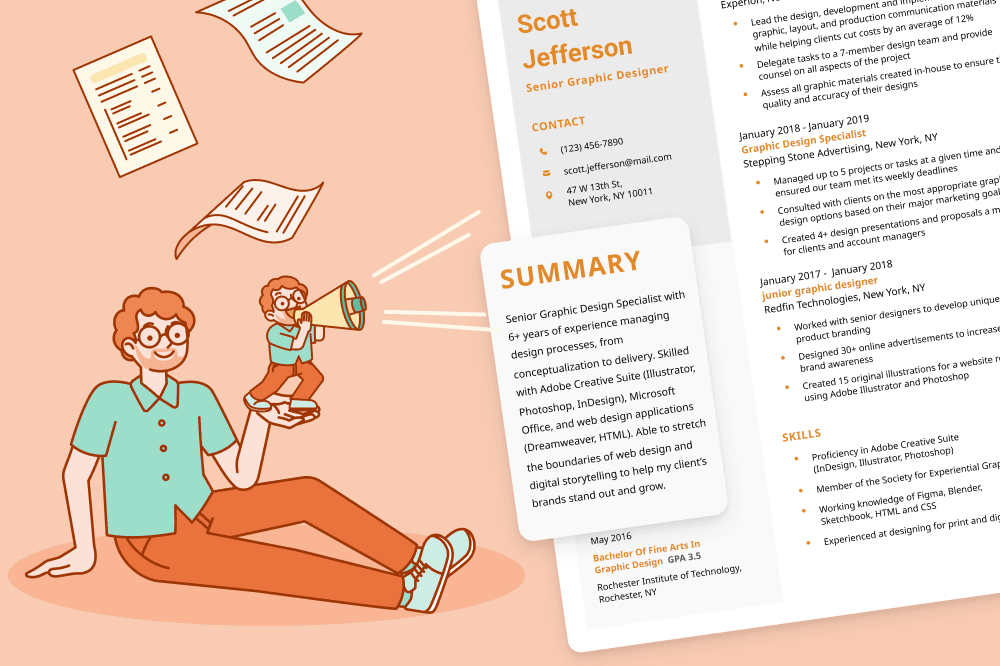
The Resume Genius Team
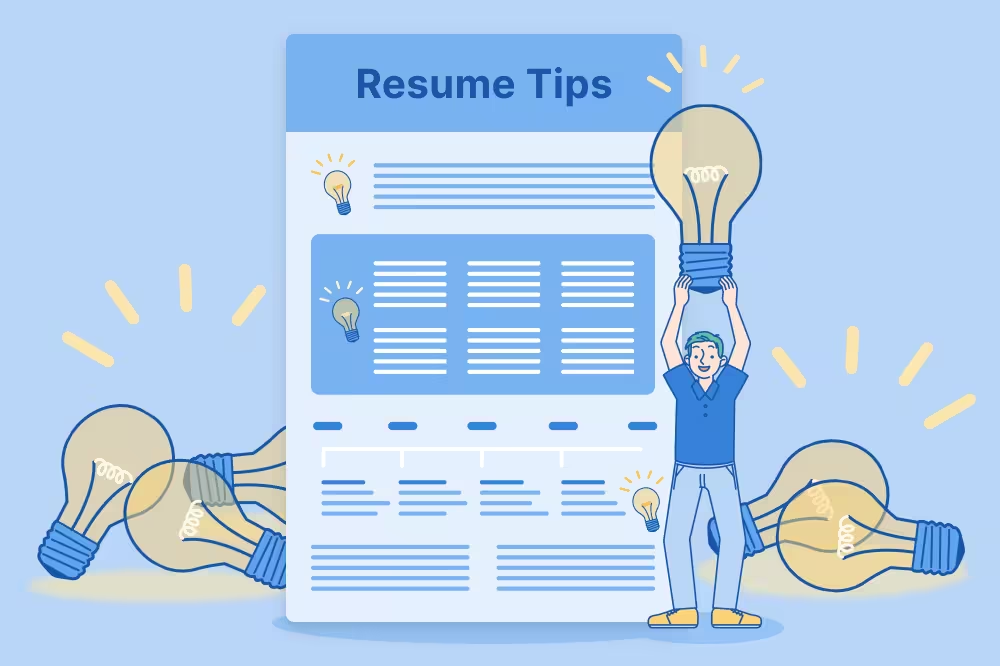
Emily Crowley
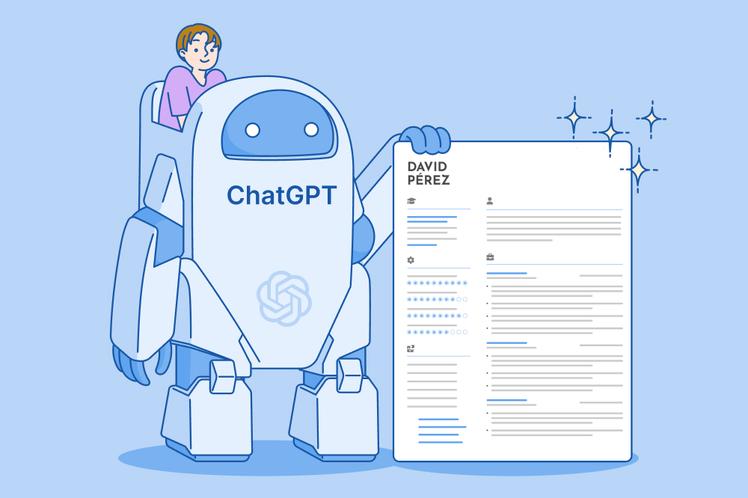
Nathan Soto
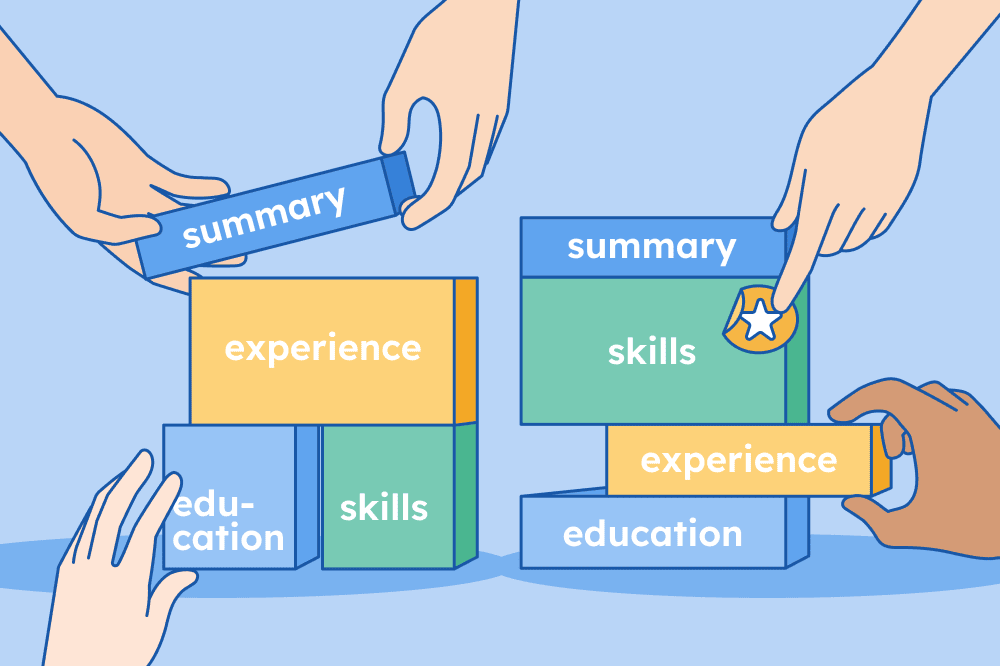
Corissa Peterson
100% FREE TEMPLATES
Use our templates to win the job.
Each template on our website was designed by HR and hiring professionals to help jobseekers easily apply for work.
Sign up for more free templates & career resources!
In addition to this template, you'll also receive:
- Early access to our newest premium templates
- Job-specific resume tips & free examples
- Access to our exclusive newsletter for jobseekers
- Notifications of product improvements
* By sharing your email, you agree to receive marketing emails from our team. You can easily opt out of future emails on the dashboard of your account or by unsubscribing directly from the link at the bottom of an email you receive from us.
Want to apply for jobs faster?
Try our builder software to make your own professional resume and cover letter in minutes. Just fill out a few details, and let our easy-to-use tools handle the rest.
How to Write a Resume for College Applications
BestColleges.com is committed to delivering content that is objective and actionable. To that end, we have built a network of industry professionals across higher education to review our content and ensure we are providing the most helpful information to our readers.
Drawing on their firsthand industry expertise, our Integrity Network members serve as an additional step in our editing process, helping us confirm our content is accurate and up to date. These contributors:
- Suggest changes to inaccurate or misleading information.
- Provide specific, corrective feedback.
- Identify critical information that writers may have missed.
Integrity Network members typically work full time in their industry profession and review content for BestColleges.com as a side project. All Integrity Network members are paid members of the Red Ventures Education Integrity Network.
Explore our full list of Integrity Network members.
- High school resumes for college differ from professional resumes.
- A resume for college applications should use bullet points and employ strong action verbs.
- Resumes for college applications should include academic history, awards, and activities.
- Opinions on the importance of high school resumes for college vary.
Most U.S. colleges have similar application processes . Many schools use the Common App , and prospective students usually need to submit official transcripts, ACT or SAT scores, one or more personal essays , letters of recommendation , and a resume.
The resume is often the trickiest part for applicants, as many high school students do not have much professional experience. Unlike a traditional resume, however, a college application resume focuses more on extracurricular activities, academic performance, volunteer experience, hobbies, and awards than it does on employment history.
Still, putting together this document can seem daunting for many students. We created this guide to alleviate that stress. Read on to learn more about how to write a resume for college applications.
How Important Is a High School Resume for College?
Not all college applications require a resume, but it’s always good to submit a resume if it’s an option.
For example, the Common App only requires an activities list. However, you can still submit a resume, which can provide schools with a fuller picture of your academic performance, interests, and hobbies. You can also upload a resume to the locker section of the Coalition Application .
While some college admissions experts place premium importance on college application resumes, others do not. A resume shows admissions departments evidence of your academic achievements during high school. It also demonstrates your work and volunteer experiences, and what you can bring to the community beyond the classroom.
Don’t embellish, but do include unique experiences and specific accomplishments to stand out from the crowd. You should also avoid generalities and cliches.
Additionally, your resume can help your recommenders write the best possible letters for your applications. You can also submit your resume as part of scholarship applications .
What to Include in a Resume for College Applications
A college resume differs from a typical professional resume in several ways. Below, we go over what to put down on your high school resume for college.
Name and Contact Information
The top or header of your resume should include your full name and email address, phone number, and home address. If you have a personal website or LinkedIn profile showcasing your work or achievements, you can also include those URLs in this section.
Education and Academic Accomplishments
In this section, list the name of your high school and the dates you attended. You can also provide information like your GPA and class rank , AP or IB courses you’ve taken, and your ACT or SAT scores if you think they’ll help your case.
Work and/or Volunteer Experience
For high schoolers, work experience can include internships , part-time jobs, job shadowing, and study abroad experiences. Volunteer experience can be particularly important on a high school resume for college, as it demonstrates to admissions departments that you’re willing to contribute to your community. Make sure to highlight any leadership positions you held or currently hold.
Extracurricular Activities
Colleges want students who participate in and contribute to campus life beyond the classroom. You can mention sports, clubs, and non-school-related activities that you participated in. This section helps colleges get a more complete picture of who you are and what you care about.
Honors and Awards
You can list your proudest achievements in this section. Include academic awards received from your school, ranks from external organizations (like Eagle Scout or Gold Award), and any athletic accomplishments.
Skills, Interests, and Achievements
In this section, you can mention languages you speak, computer skills, and soft skills like teamwork, communication, and leadership. You can also briefly mention hobbies you’re passionate about, especially if they relate to the major you plan to pursue in college.
How to Write a Resume for College: 5 Essential Tips
How you structure and write your resume is almost as important as what you include.
For instance, resumes for college applications should list all achievements, jobs, volunteer experience, and awards in reverse chronological order. The most recent job should be at the top of the section, with your previous position below it, and so on. You can see how this looks on our resume example below.
But first, here are five essential tips on how to write a resume for college.
1. Include a Professional Email Address
A professional email address — perhaps [email protected], or a similar choice — sends the right message to colleges. Colleges may not hold an unprofessional email address against you; however, providing a simple email address that includes your name is a better choice just in case.
2. Start With Your Education
Unlike a professional resume, a college resume should feature your education at the top. Colleges understand that if you’re a first-year applicant, you likely don’t have much, if any, professional experience. Colleges are first and foremost educational institutions. As such, academic performance is the most important factor in determining who to accept.
3. Use Bulleted Lists
You should always use bullet points instead of paragraphs when listing information in your resume. Bullet points make your resume easier to read. Admissions departments wade through thousands of resumes. They’re much more likely to read and consider a clean, digestible list of your accomplishments than a dense, muddled document.
4. Employ Strong Action Verbs
Use strong action verbs with each bullet point in your resume. For example, if you worked as the manager of an ice cream shop during the summer, avoid writing “was the manager at Scoops Ahoy” as a bullet point. Instead, try “directed a team of five employees” or “trained five employees in company policies.”
5. Limit It to One Page
No resume should extend past one page. Even after high school, a resume longer than a page is more like a curriculum vitae, or CV . In high school, a long resume likely contains fluff and filler. Keeping your resume to one page is good practice for writing concisely — a crucial skill in college and beyond.
College Application Resume Example
Derek Henry 150 15th Ave. South Nashville, TN 37212 (615) 777-7777 [email protected]
Hillsboro High School, Class of 2021 GPA: 3.9
- Administrative Assistant, Tennessee Titans (2019-Present)
- Maintain and clean player equipment in locker room.
- Coordinate community outreach programs with local middle schools.
- Organize player scouting reports for front office.
- Student Volunteer Coordinator, Habitat for Humanity (2018-Present)
- Participated in five 50-hour builds in different Nashville neighborhoods.
- Led and organized 8-10 students who participated in builds.
- President, Habitat for Humanity Club (2018-Present)
- Secretary, Yoga Club (2018-Present)
- Member, Ultimate Frisbee Team (2017-Present)
- Running Back, Football Team (2017-Present)
- Principal’s List, Six Semesters
- Cum Laude Society
- National Merit Finalist
- Outstanding Senior, 2021
- Computer: Microsoft Word, Adobe Photoshop
- Language: Spanish (conversational)
Feature Image: pondsaksit / iStock / Getty Images Plus / Getty Images

IMAGES
VIDEO
COMMENTS
Knowing how to prepare a quality, well-written resume can help you enhance your applications to colleges and universities. In this article, we explain what to include in a college admissions resume, offer steps and tips for writing one and provide a template and example resume to guide you in creating your own.
Our guide has tips, right and wrong examples, and a ready-made template that you can use to write the ultimate college application resume!
Down below, we’ll dive right into what a college resume is and how to write a college resume. You’ll even find three college application resume examples and a college application resume template to help you start your own.
In this guide, I’ll show you: 4 college application resume examples. How to write a resume for college application that gets you into the best institutions. What to include on a high school resume for college. Tips & tricks to get your college resume template noticed.
How to Write a Resume for a College Application. An effective college resume is essential for getting accepted into your dream school as a high school graduate. Scroll down to find out how you can write a college application resume that helps you get into the college you want. Build My Resume Now.
Learn how to write a resume for college and see a real college resume example. High school resumes for college differ from professional resumes. A resume for college applications should use bullet points and employ strong action verbs.